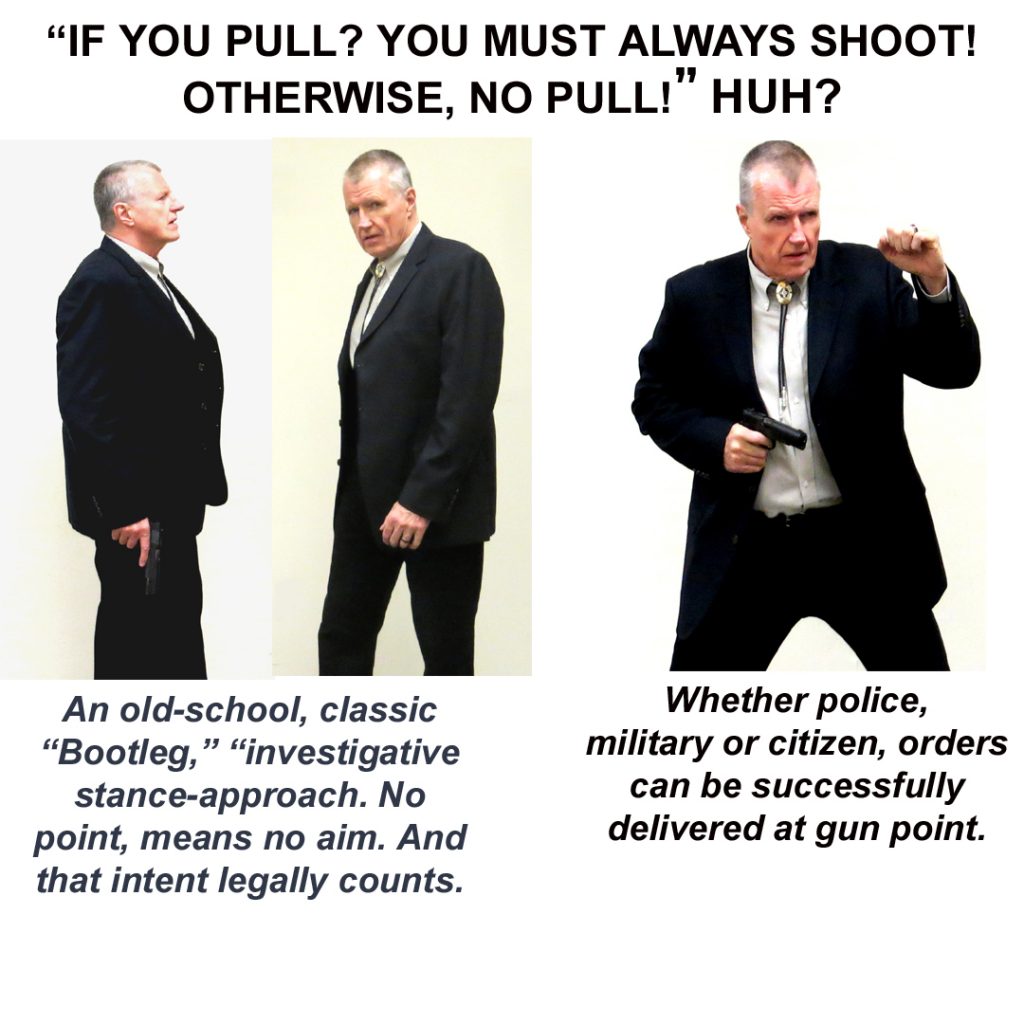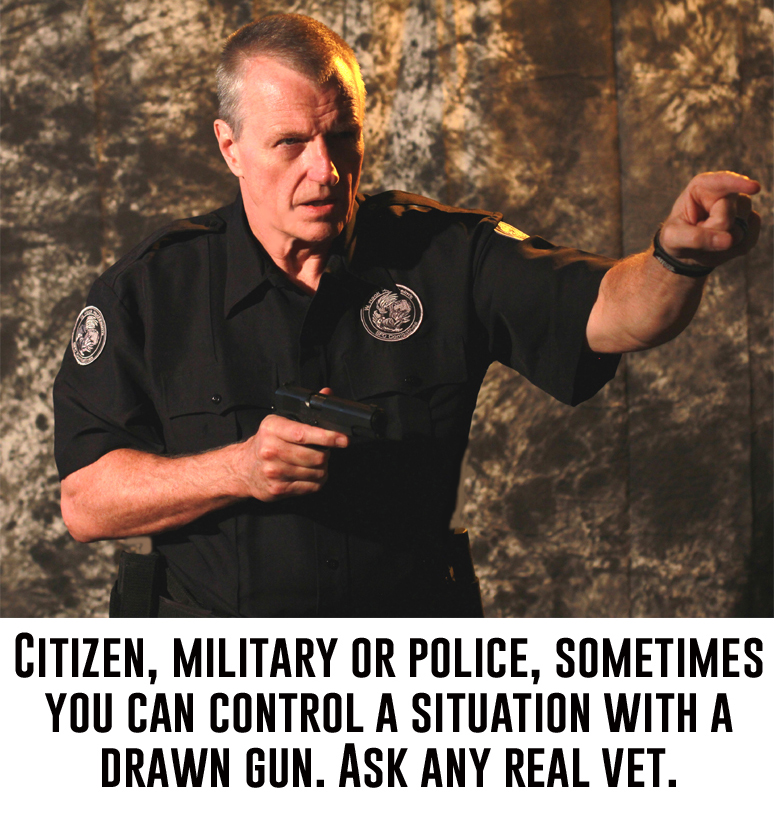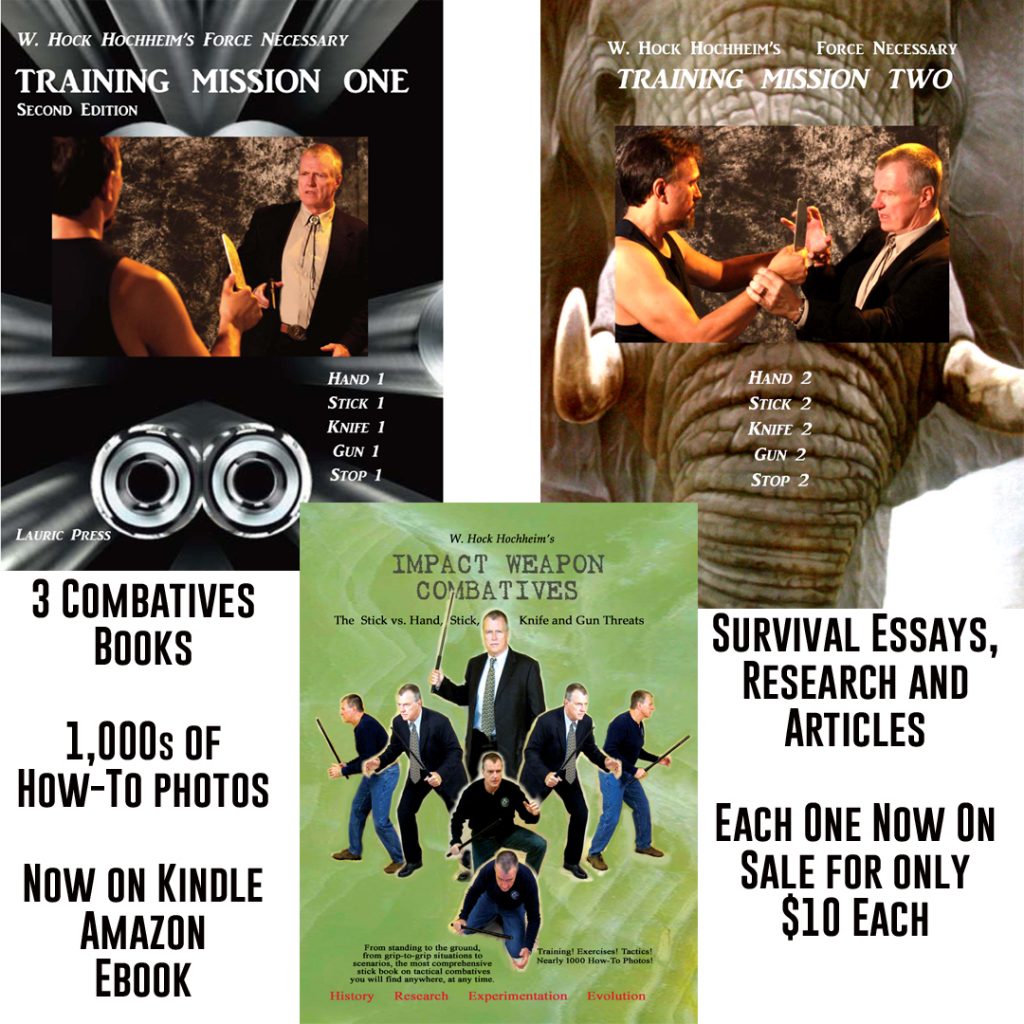
And yes, some of these people were detached airheads. Several demanded that we never, ever pull-draw guns unless we absolutely have to shoot a bad guy, All other times, the gun must remain holstered. Only draw and must shoot. Must draw? Then must shoot! We would look at each other and think, and later complain in private powwows:
- “Has this idiot ever searched a building or home after an alarm or invader threat?”
- “Has this knucklehead never made a felony traffic stop?”
- “Has this yahoo never…… (on and on with this list).”
Apparently not! How could some supervisors in law enforcement be this ignorant. But this idea transcends policing. I bring these memories up because, lately in my teaching travels, sometimes big, sometimes small, I have run across citizens who have been smart enough to attend concealed carry classes or other entry-level, defensive tactics courses. They attend my “Force Necessary: Gun” courses also. When teaching this and organizing class training to make decisions, a number of attendees are graduates of simplistic, entry-level, CCH and intro “def-tacts” from other programs. Some of these attendees have approached me and said –
“Well, they told us in _______ that we only draw our pistol in severest, deadly force situations and can only draw to shoot to kill-stop. You can’t pull your gun unless you also intend to shoot to kill-stop.”
Ooooh boy. That old chestnut again. I just look at them, flabbergasted, and wonder “who are these teachers?” And how can I undo this kindergarten, mentality message. I try to explain that I use a commandment list of “Assess, Draw-and-Assess,” decision-making based on many actual events.
Assess, Draw and Access, the big five decisions:
1: There-Not There.
2: Pull-Don’t Pull.
3: Aim-Don’t Aim.
4: Shoot-Don’t Shoot.
5: Leave-Don’t leave.
These decisions may all occur in 2 seconds or half an hour! Yeah. Situational. I am not writing this today to dissect the list of 5 materials, as I have written long essays on each, elsewhere. Each of the 5 have a successful history in situational, real-world defense, crime and even war.
I always repeat the old studies once so easily found in DOJ – Department of Justice – annual reports about firearms use. Each year there was a statistic that about 69% of the time when a gun (or knife, not stick) was drawn by the intended victim, the criminal left. Sure, each situation was ugly and scary (I report some actual situations to attendees) but this was an average end result over the years. Sometime in the 2000s this routine annual stat became really hard and then impossible to find, because it does not suit the political powers that be. This cause was then picked up by various pro-gun groups and their publications. They regularly report successful citizen, gun, crime-fighting events, but they are declared as right-wing bias and they do not carry the mojo of a government report.
Yet, these successful events happen frequently, and you are deprived of the truth. When things go unusually “bump in your house, bump in the church, bump in the school, bump in the stores-malls, bump in the wherever” you may be in a position to pull your gun and assess. Remember the best quick draw is pulling your gun out just before you really needed it. (We’ve dissected “brandishing” in detail another essay here.)
Gun instructors. Here in the United States, while I and others consider the rising plethora of non-police experienced and non-military-experienced gun instructors, their presence is still a good thing in general. Hey, it’s become a cottage industry hasn’t it? Citizens teaching gun courses and school and church-shooting courses, etc.. I still think It’s a good thing overall because we’ve noticed they’ve-we’ve achieved a overall higher level of good material. The bar has risen. Overall? Good. But for some of us, sometimes, we can’t help but wonder about some of them and ask,
- “Okay, who is teaching what in these courses regularly?” and,
- “That guy said…what now?”
If questionable recollections, are these students misinterpreting what the instructor actually meant or said?” That’s certainly possible. But, police, military, citizen instructors and their courses all need to vetted by customers, sure. And, needless to say within those jobs, there is job leakage that won’t fit. For examples-
- Do police really need military-based shooting courses?
- Do the military really need police shooting courses?
- Do citizens really need police and-or military shooting courses?
To some extent? Well, yes. To some extent? Well, no. Careful! Reduce the abstract. Its my old “who, what, where, when, how and why questions.”
It might be so quick, so easy and so legally course-sue-safe, especially for the class and instructor, to declare in a very brief citizen gun course that you can ONLY draw and shoot. Mandatory! But then, you can’t just draw and assess? Scare off? Issue verbal commands? Hide and ambush? Etc. Customize survival thinking to the plethora of situations?

Quick legal message, “point-don’t point” also means “aim-don’t aim” and are legal evaluations in court and internal affairs police investigations. For a reason!
I try to explain, but what really sinks in best is classes replicating and making them do repetitions with simulated ammo. Working through actual situations where each of the 5 decision steps above have historically worked and why they are so important. From a legal standpoint, these options must be explained and must be taught. Sometimes you CAN and SHOULD draw WITHOUT shooting.
Check out the Training Mission Books, which cover gun combatives. Click right here.
